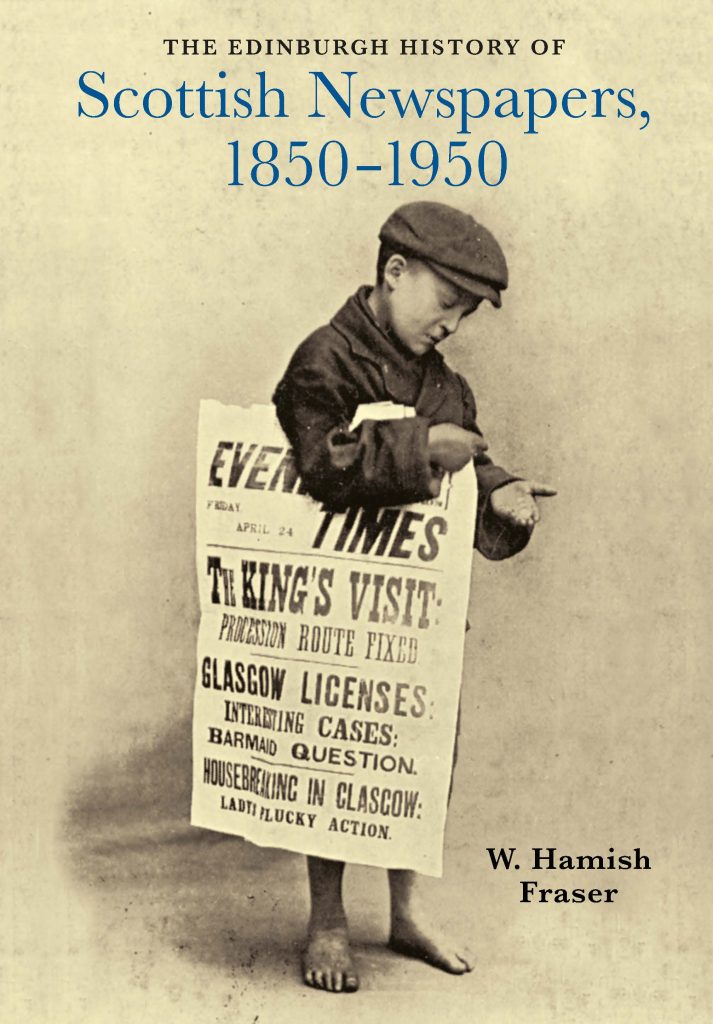
by Hamish Fraser
With the readership of daily newspapers at the present day falling drastically and local newspapers struggling to survive, a study of Scottish newspapers in their heyday is timely.
In the century after 1850, it was from newspapers – and particularly local newspapers – that people got their news, their opinions and their understanding of the world they lived in. Until well into the twentieth century the purchase of a daily newspaper was largely confined to the better off, but local weekly newspapers were read by all social classes, passed around and often despatched to friends and family scattered around the world. And the editors of the best local papers, such as the Ardrossan & Saltcoats Herald, the Banffshire Journal, the Peterhead Sentinel, the Southern Reporter or the John o’Groat Journal, were not slow in making their views known…
They commented not only on local issues, but on national and international affairs. And yet, most of these highly influential people, who came from a variety of social and educational backgrounds, with many self-educated, are largely forgotten and sometimes unknown. Rescuing these opinion formers and the interpreters of the world from relative obscurity is one of the tasks of this first general history of the Scottish press in that century.
It’s also possible to see the process of social change through the newspapers. Many of the journalists initially saw their task as being to educate and ‘improve’ their readership, intellectually, aesthetically and even morally. More than one editor saw himself as the modern preacher, replacing the once-powerful clergy. But market pressures brought changes. A more widely literate readership wanted less preaching and more football reporting, horse-racing results, entertaining stories and fashion, not forgetting the titillation of gory or salacious court cases. Newspapers gradually learned to provide.
Amidst all this can be detect various recurring themes in both daily and weekly papers that helped maintain and shape particular perceptions of Scottishness. There was a confidence that the Scots were more democratic, more Liberal than their southern neighbours. There was a view that, although Presbyterianism had a history of authoritarianism, at the same time it contributed to a democratic, free-thinking state of mind, assisted by a popular educational system with its roots in John Knox’s ambitions. These were powerful myths which helped maintain the idea of a distinctive Scottish nation within the British state. There was also a persistent concern to show that Scotland’s relationship with the British state was quite different from that of Ireland and, therefore, there was not the need for home rule. All that was required was for Westminster to recognise that there were grievances that needed to be responded to.
In the first half of the twentieth century market pressures were thinning out the daily newspapers. Few cities could support two locally-based dailies that had once had provided political alternatives. Now the Scotsman and the Glasgow Herald were in competition with papers owned by London-based conglomerates like the Daily Record, the Daily Express and the Daily Mail, that were creating a British-wide market at a cheaper price.
Local weeklies, in contrast, still remained largely family-owned even until 1950, although the process of merger was beginning. But most had lost their confidence. They saw their role as expressing few opinions and doing little more than reporting the activities of local organisations. Opinion on matters other than the most mundane were filtered through London. Just as with the daily papers, where once they had been advocates of progressive change, the tone was now one of caution and resistance to innovation.
It was century of exciting and dramatic change in the means of production of newspapers, the nature of their readership, the variety of content and the nature of the work-force. With television set to shape the national agenda after 1950, the golden age of newspapers was coming to an end.

About the book
The Edinburgh History of Scottish Newspapers, 1850-1950 by W. Hamish Fraser
Presents the first comprehensive examination of daily and weekly newspapers in Scotland in the century after 1850
About the author
Formerly professor of Modern History at the University of Strathclyde, W. Hamish Fraser has published numerous books on labour, social and urban history, but has long had an interest in newspaper history and has published a life of the great war correspondent, Archibald Forbes (AUP 2015).





